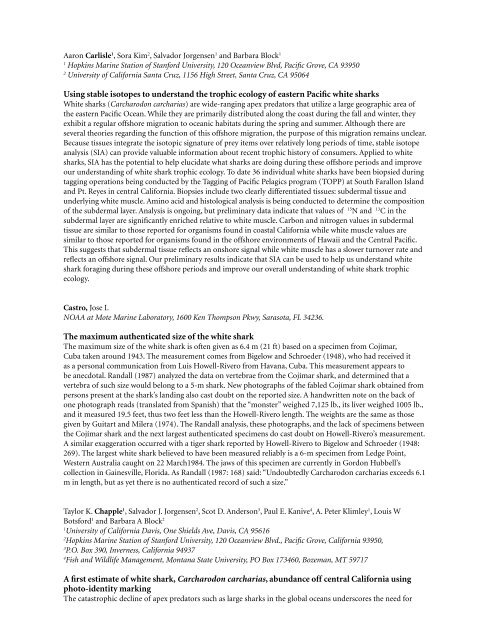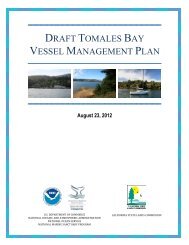Symposium program - Gulf of the Farallones National Marine ...
Symposium program - Gulf of the Farallones National Marine ...
Symposium program - Gulf of the Farallones National Marine ...
Create successful ePaper yourself
Turn your PDF publications into a flip-book with our unique Google optimized e-Paper software.
Aaron Carlisle 1 , Sora Kim 2 , Salvador Jorgensen 1 and Barbara Block 1<br />
1<br />
Hopkins <strong>Marine</strong> Station <strong>of</strong> Stanford University, 120 Oceanview Blvd, Pacific Grove, CA 93950<br />
2<br />
University <strong>of</strong> California Santa Cruz, 1156 High Street, Santa Cruz, CA 95064<br />
Using stable isotopes to understand <strong>the</strong> trophic ecology <strong>of</strong> eastern Pacific white sharks<br />
White sharks (Carcharodon carcharias) are wide-ranging apex predators that utilize a large geographic area <strong>of</strong><br />
<strong>the</strong> eastern Pacific Ocean. While <strong>the</strong>y are primarily distributed along <strong>the</strong> coast during <strong>the</strong> fall and winter, <strong>the</strong>y<br />
exhibit a regular <strong>of</strong>fshore migration to oceanic habitats during <strong>the</strong> spring and summer. Although <strong>the</strong>re are<br />
several <strong>the</strong>ories regarding <strong>the</strong> function <strong>of</strong> this <strong>of</strong>fshore migration, <strong>the</strong> purpose <strong>of</strong> this migration remains unclear.<br />
Because tissues integrate <strong>the</strong> isotopic signature <strong>of</strong> prey items over relatively long periods <strong>of</strong> time, stable isotope<br />
analysis (SIA) can provide valuable information about recent trophic history <strong>of</strong> consumers. Applied to white<br />
sharks, SIA has <strong>the</strong> potential to help elucidate what sharks are doing during <strong>the</strong>se <strong>of</strong>fshore periods and improve<br />
our understanding <strong>of</strong> white shark trophic ecology. To date 36 individual white sharks have been biopsied during<br />
tagging operations being conducted by <strong>the</strong> Tagging <strong>of</strong> Pacific Pelagics <strong>program</strong> (TOPP) at South Farallon Island<br />
and Pt. Reyes in central California. Biopsies include two clearly differentiated tissues: subdermal tissue and<br />
underlying white muscle. Amino acid and histological analysis is being conducted to determine <strong>the</strong> composition<br />
<strong>of</strong> <strong>the</strong> subdermal layer. Analysis is ongoing, but preliminary data indicate that values <strong>of</strong> δ 15 N and δ 13 C in <strong>the</strong><br />
subdermal layer are significantly enriched relative to white muscle. Carbon and nitrogen values in subdermal<br />
tissue are similar to those reported for organisms found in coastal California while white muscle values are<br />
similar to those reported for organisms found in <strong>the</strong> <strong>of</strong>fshore environments <strong>of</strong> Hawaii and <strong>the</strong> Central Pacific.<br />
This suggests that subdermal tissue reflects an onshore signal while white muscle has a slower turnover rate and<br />
reflects an <strong>of</strong>fshore signal. Our preliminary results indicate that SIA can be used to help us understand white<br />
shark foraging during <strong>the</strong>se <strong>of</strong>fshore periods and improve our overall understanding <strong>of</strong> white shark trophic<br />
ecology.<br />
Castro, Jose I.<br />
NOAA at Mote <strong>Marine</strong> Laboratory, 1600 Ken Thompson Pkwy, Sarasota, FL 34236.<br />
The maximum au<strong>the</strong>nticated size <strong>of</strong> <strong>the</strong> white shark<br />
The maximum size <strong>of</strong> <strong>the</strong> white shark is <strong>of</strong>ten given as 6.4 m (21 ft) based on a specimen from Cojímar,<br />
Cuba taken around 1943. The measurement comes from Bigelow and Schroeder (1948), who had received it<br />
as a personal communication from Luis Howell-Rivero from Havana, Cuba. This measurement appears to<br />
be anecdotal. Randall (1987) analyzed <strong>the</strong> data on vertebrae from <strong>the</strong> Cojímar shark, and determined that a<br />
vertebra <strong>of</strong> such size would belong to a 5-m shark. New photographs <strong>of</strong> <strong>the</strong> fabled Cojímar shark obtained from<br />
persons present at <strong>the</strong> shark’s landing also cast doubt on <strong>the</strong> reported size. A handwritten note on <strong>the</strong> back <strong>of</strong><br />
one photograph reads (translated from Spanish) that <strong>the</strong> “monster” weighed 7,125 lb., its liver weighed 1005 lb.,<br />
and it measured 19.5 feet, thus two feet less than <strong>the</strong> Howell-Rivero length. The weights are <strong>the</strong> same as those<br />
given by Guitart and Milera (1974). The Randall analysis, <strong>the</strong>se photographs, and <strong>the</strong> lack <strong>of</strong> specimens between<br />
<strong>the</strong> Cojímar shark and <strong>the</strong> next largest au<strong>the</strong>nticated specimens do cast doubt on Howell-Rivero’s measurement.<br />
A similar exaggeration occurred with a tiger shark reported by Howell-Rivero to Bigelow and Schroeder (1948:<br />
269). The largest white shark believed to have been measured reliably is a 6-m specimen from Ledge Point,<br />
Western Australia caught on 22 March1984. The jaws <strong>of</strong> this specimen are currently in Gordon Hubbell’s<br />
collection in Gainesville, Florida. As Randall (1987: 168) said: “Undoubtedly Carcharodon carcharias exceeds 6.1<br />
m in length, but as yet <strong>the</strong>re is no au<strong>the</strong>nticated record <strong>of</strong> such a size.”<br />
Taylor K. Chapple 1 , Salvador J. Jorgensen 2 , Scot D. Anderson 3 , Paul E. Kanive 4 , A. Peter Klimley 1 , Louis W<br />
Botsford 1 and Barbara A Block 2<br />
1<br />
University <strong>of</strong> California Davis, One Shields Ave, Davis, CA 95616<br />
2<br />
Hopkins <strong>Marine</strong> Station <strong>of</strong> Stanford University, 120 Oceanview Blvd., Pacific Grove, California 93950,<br />
3<br />
P.O. Box 390, Inverness, California 94937<br />
4<br />
Fish and Wildlife Management, Montana State University, PO Box 173460, Bozeman, MT 59717<br />
A first estimate <strong>of</strong> white shark, Carcharodon carcharias, abundance <strong>of</strong>f central California using<br />
photo-identity marking<br />
The catastrophic decline <strong>of</strong> apex predators such as large sharks in <strong>the</strong> global oceans underscores <strong>the</strong> need for







